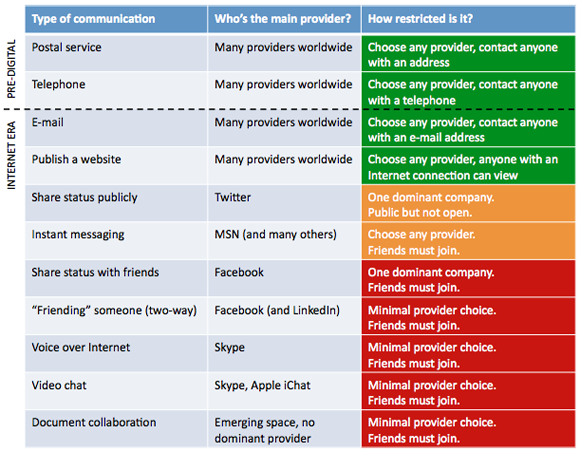
When I call you, I don’t care who your service provider is. When I send a letter, I don’t care who delivers it to the door. But with online communication, it’s not so simple. If I want to “friend” you, I can only do so if we both use Facebook. If I want to share a thought publicly, you’re unlikely to see it unless you’re on Twitter, too. Twitter, Facebook, MSN and Skype are new forms of communication that did not exist before the Internet – but unlike their old world equivalents, they’re controlled by corporations and the messages you send with them are restricted in audience and reach.
Much of the media attention on Twitter and Facebook is on the products and the companies behind them, but we would do well to stop thinking in those terms, like we did with email, and start thinking more about the means of communication that they provide.
It’s only when we take a step back and think about the digital communications revolution in these terms, that the picture becomes evident. It’s not a pretty one. Almost every form of digital communication is dominated by one company, and locked in to members of that service (See table below). We are in a poor state for a free, open exchange of ideas.
Back in the early nineties, Compuserve and AOL only allowed you to email other customers on their own network, exactly like Facebook does today. It was only when common “protocols” emerged, such as the positioning of the username, @ sign and domain name, that these private e-mail networks were able to exchange messages, and e-mail as we know it today was born.
Without open e-mail, would we have seen the explosion in e-commerce that’s taken place over the last ten years? How much innovation and commerce is being stifled by the closed, restricted methods for status sharing, instant messaging and video chat?
We need new communication protocols, new standard ways to share status, chat by video or “friend” someone (Though it’s not obvious, “friending” is a form of communication too – establishing a two-way connection between two people, represented electronically, without needing to exchange addresses). Some standards exist, such as XMPP for chat, VOIP for Internet telephony and Wave for document collaboration, but communication providers resist adopting them and the general public don’t understand them yet. There are no standards for status sharing or storing friend connections.
Software engineers need to improve these protocols and create new ones, businesses need to adopt them, and we as customers need to demand them. Communications standards must succeed if we are to guarantee a free, open future for Internet communication.
Image credit: “Gagged” by gorrilaradio on Flickr








 @
@
 Tags:
Tags: 


 Like all images on the site, the topic icons are based on images used under Creative Commons or in the public domain. Originals can be found from the following links. Thanks to
Like all images on the site, the topic icons are based on images used under Creative Commons or in the public domain. Originals can be found from the following links. Thanks to